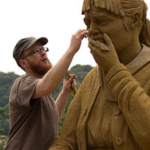We walked from the Taj Mahal, the seventh wonder of the world glistening like a pearl on the horizon. The Mughal Emperor Shah Jahan built it over twenty years as a morsoleam for his late wife Mumtaz Mahal as a gesture of his love and finished it in 1653.
We visited a stone workshop where they shared some of the secrets of how the intricate carvings were made and precious stones inserted to make wonderful patterns and decoration. Near by is the Red Fort of Agra where Shah Jahan was later imprisoned by his own son but could still see the Taj Mahal on the river. It is an inspirational place and now the second most visited building on earth.
We had one hiccup whilst taking a ‘selfie’ on Claire’s iPhone of us in front of the Taj Mahal. The Taj was over exposed because of my white skin. “Jamie, just press on the Taj Mahal and it will expose for that”. So I just followed instructions and pressed the screen. Unfortunately the phone fell onto the floor and smashed the screen causing Claire to be a little upset. I maintain that I was just following instructions.
The demise of one of Claire’s most precious material possessions was a fitting example of our obsession with material objects in a place where poverty prospers. Outside the Taj Mahal, there are children selling trinkets and other children begging for money, led by adults. If you give money then it seems that you are encouraging a child to beg rather than go to school and consolidating a scenario where adults are forcing children to beg. The result is to watch a desperate child knocking on your car window as you drive away, gesturing to have money for food. This is a sight that will stay with me for a long time.
In Delhi the sight of blankets covering mounds is common. On the occasion you will see a bare foot popping out of one to tell the tale of a person sleeping on the streets within. Nonetheless, India is quite a wealthy country and there are many with money. The disparity of wealth here is stark.
This is not so much a critique of India, but that of human nature. In the UK during the Industrial revolution, we had very similar levels of poverty, with children working in factories picking cotton from working looms. It is a very human trait to exploit others for the gain of a few and is very clear here.
Still, it is very easy for me to see this as India’s problem. I am an English Westerner and my main concern is fixing Claire’s phone before she detonates. But then the Dalai Lama, whist accepting the Nobel Peace Prize, did so not as a Tibetan, Buddhist, or Dalai Lama, but as a human being. He feels that there is no distinction between people regardless of your social standing, nationality or religion. We are all fundamentally the same and we should be treated so.
Also, we as Western consumers do have the power to support businesses that have factories in India and other developing nations that pay people fairly and have good working conditions. Or we can support companies that encourage exploitation. The decision is ours.














